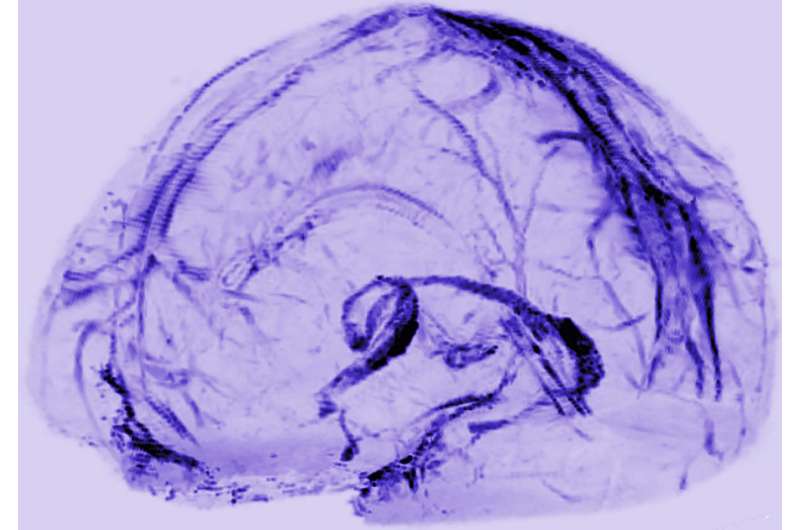Researchers uncover drain pipes in our brains

By scanning the brains of healthy volunteers, researchers at the National Institutes of Health saw the first, long-sought evidence that our brains may drain some waste out through lymphatic vessels, the body's sewer system. The results further suggest the vessels could act as a pipeline between the brain and the immune system.
"We literally watched people's brains drain fluid into these vessels," said Daniel S. Reich, M.D., Ph.D., senior investigator at the NIH's National Institute of Neurological Disorders and Stroke (NINDS) and the senior author of the study published online in eLife. "We hope that our results provide new insights to a variety of neurological disorders."
Dr. Reich is a radiologist and neurologist who primarily uses magnetic resonance imaging (MRI) to investigate multiple sclerosis and other neurological disorders which are thought to involve the immune system. Led by post-doctoral fellows, Martina Absinta, Ph.D. and Seung-Kwon Ha, Ph.D., along with researchers from the National Cancer Institute, the team discovered lymphatic vessels in the dura, the leathery outer coating of the brain.
Lymphatic vessels are part of the body's circulatory system. In most of the body they run alongside blood vessels. They transport lymph, a colorless fluid containing immune cells and waste, to the lymph nodes. Blood vessels deliver white blood cells to an organ and the lymphatic system removes the cells and recirculates them through the body. The process helps the immune system detect whether an organ is under attack from bacteria or viruses or has been injured.
In 1816, an Italian anatomist reported finding lymphatic vessels on the surface of the brain, but for two centuries, it was forgotten. Until very recently, researchers in the modern era found no evidence of a lymphatic system in the brain, leaving some puzzled about how the brain drains waste, and others to conclude that brain is an exceptional organ. Then in 2015, two studies of mice found evidence of the brain's lymphatic system in the dura. Coincidentally, that year, Dr. Reich saw a presentation by Jonathan Kipnis, Ph.D., a professor at the University of Virginia and an author of one the mouse studies.
"I was completely surprised. In medical school, we were taught that the brain has no lymphatic system," said Dr. Reich. "After Dr. Kipnis' talk, I thought, maybe we could find it in human brains?"
To look for the vessels, Dr. Reich's team used MRI to scan the brains of five healthy volunteers who had been injected with gadobutrol, a magnetic dye typically used to visualize brain blood vessels damaged by diseases, such as multiple sclerosis or cancer. The dye molecules are small enough to leak out of blood vessels in the dura but too big to pass through the blood-brain barrier and enter other parts of the brain.
At first, when the researchers set the MRI to see blood vessels, the dura lit up brightly, and they could not see any signs of the lymphatic system. But, when they tuned the scanner differently, the blood vessels disappeared, and the researchers saw that dura also contained smaller but almost equally bright spots and lines which they suspected were lymph vessels. The results suggested that the dye leaked out of the blood vessels, flowed through the dura and into neighboring lymphatic vessels.
To test this idea, the researchers performed another round of scans on two subjects after first injecting them with a second dye made up of larger molecules that leak much less out of blood vessels. In contrast with the first round of scans, the researchers saw blood vessels in the dura but no lymph vessels regardless of how they tuned the scanner, confirming their suspicions.
They also found evidence for blood and lymph vessels in the dura of autopsied human brain tissue. Moreover, their brain scans and autopsy studies of brains from nonhuman primates confirmed the results seen in humans, suggesting the lymphatic system is a common feature of mammalian brains.
"These results could fundamentally change the way we think about how the brain and immune system inter-relate," said Walter J. Koroshetz, M.D., NINDS director.
Dr. Reich's team plans to investigate whether the lymphatic system works differently in patients who have multiple sclerosis or other neuroinflammatory disorders.
"For years we knew how fluid entered the brain. Now we may finally see that, like other organs in the body, brain fluid can drain out through the lymphatic system," said Dr. Reich.
More information: Martina Absinta et al. Human and nonhuman primate meninges harbor lymphatic vessels that can be visualized noninvasively by MRI, eLife (2017). DOI: 10.7554/eLife.29738





















